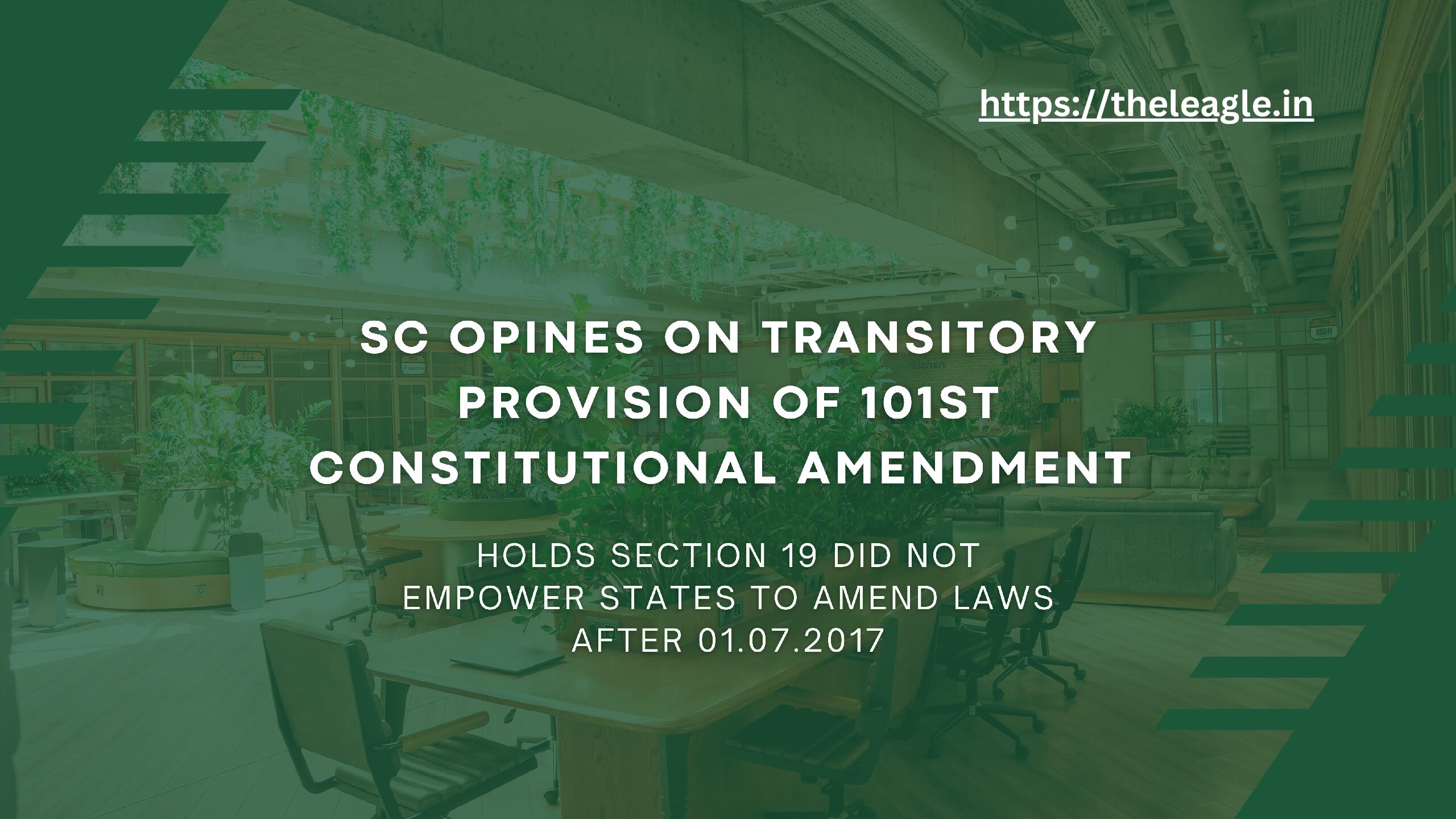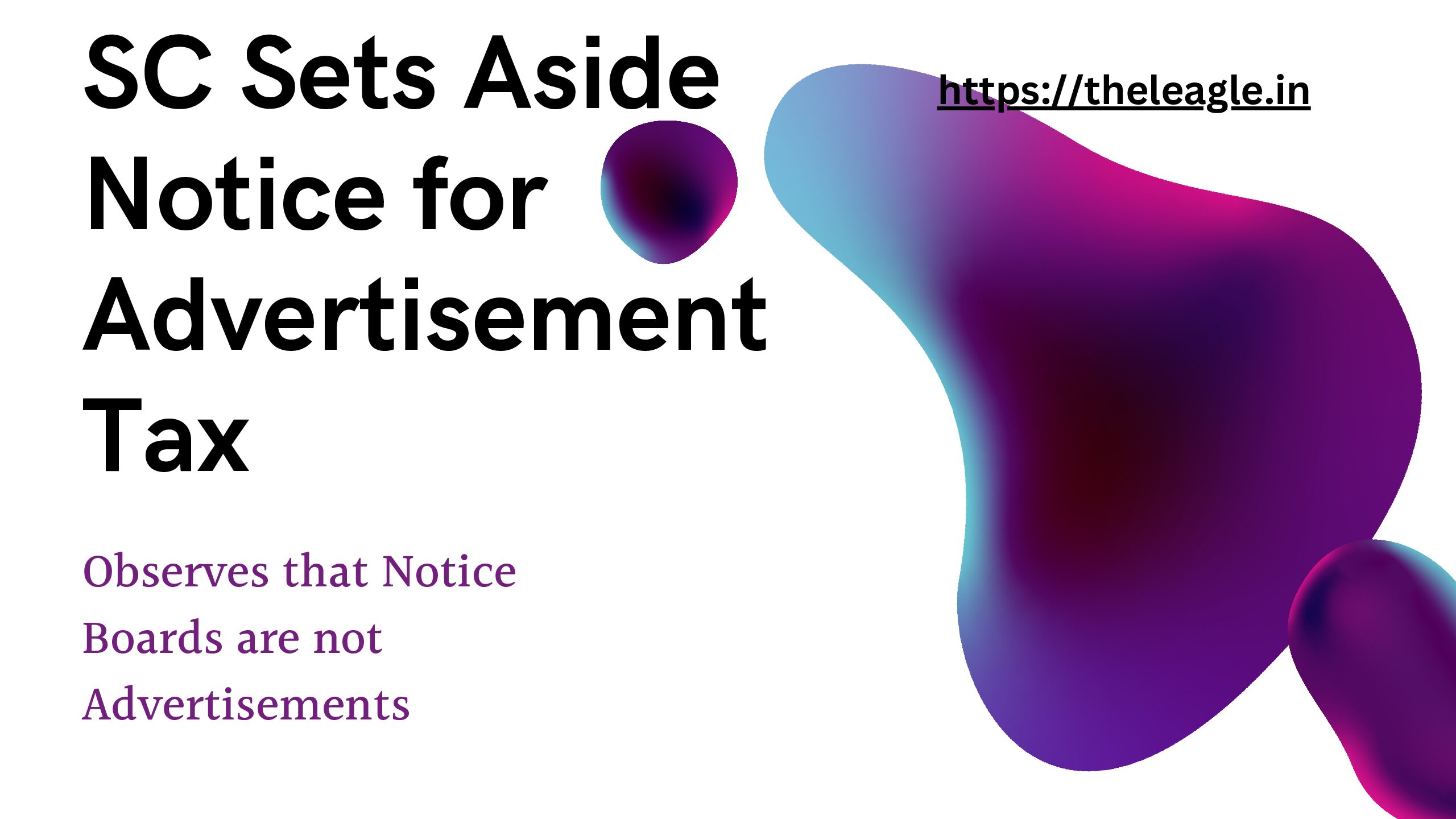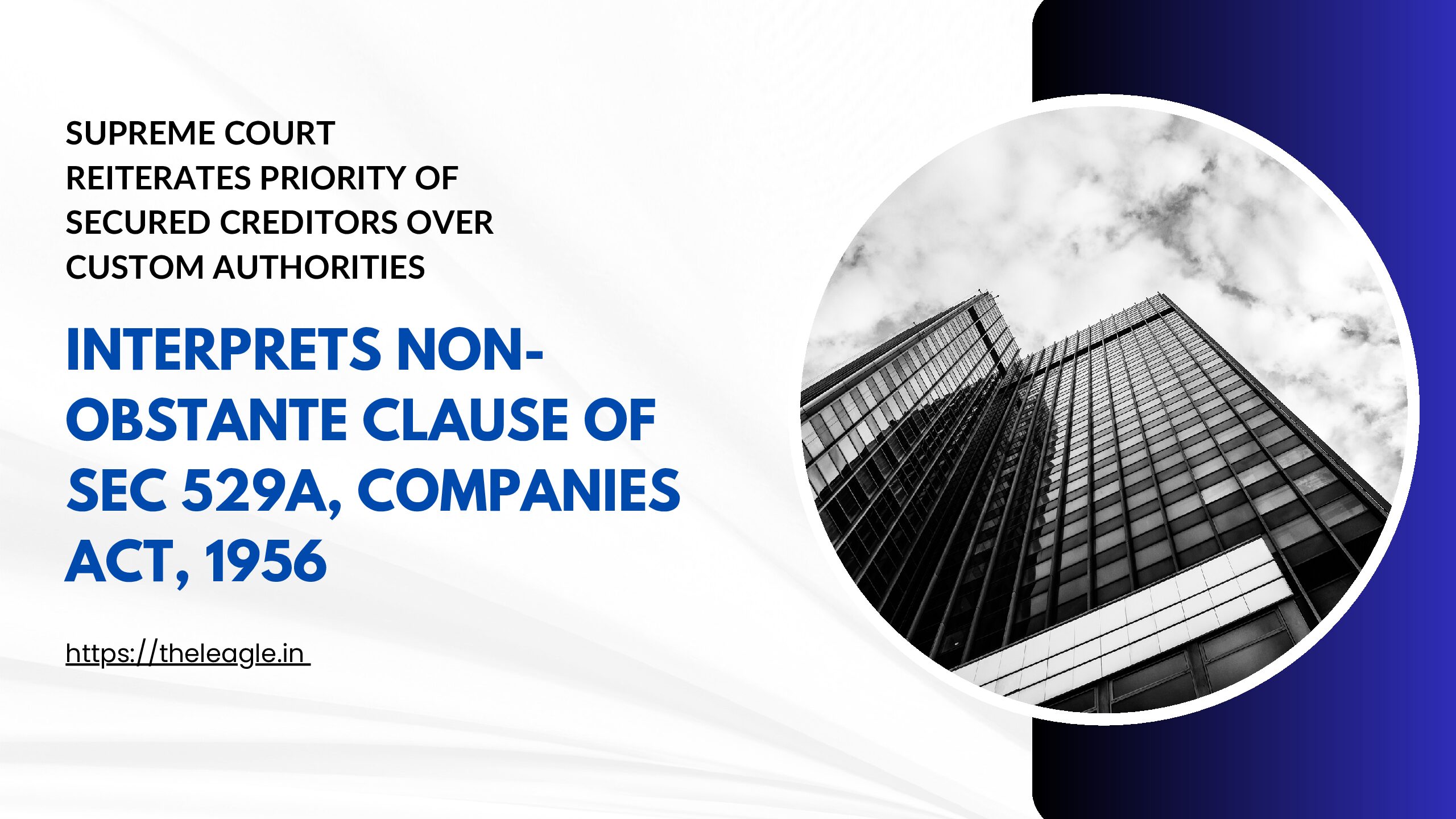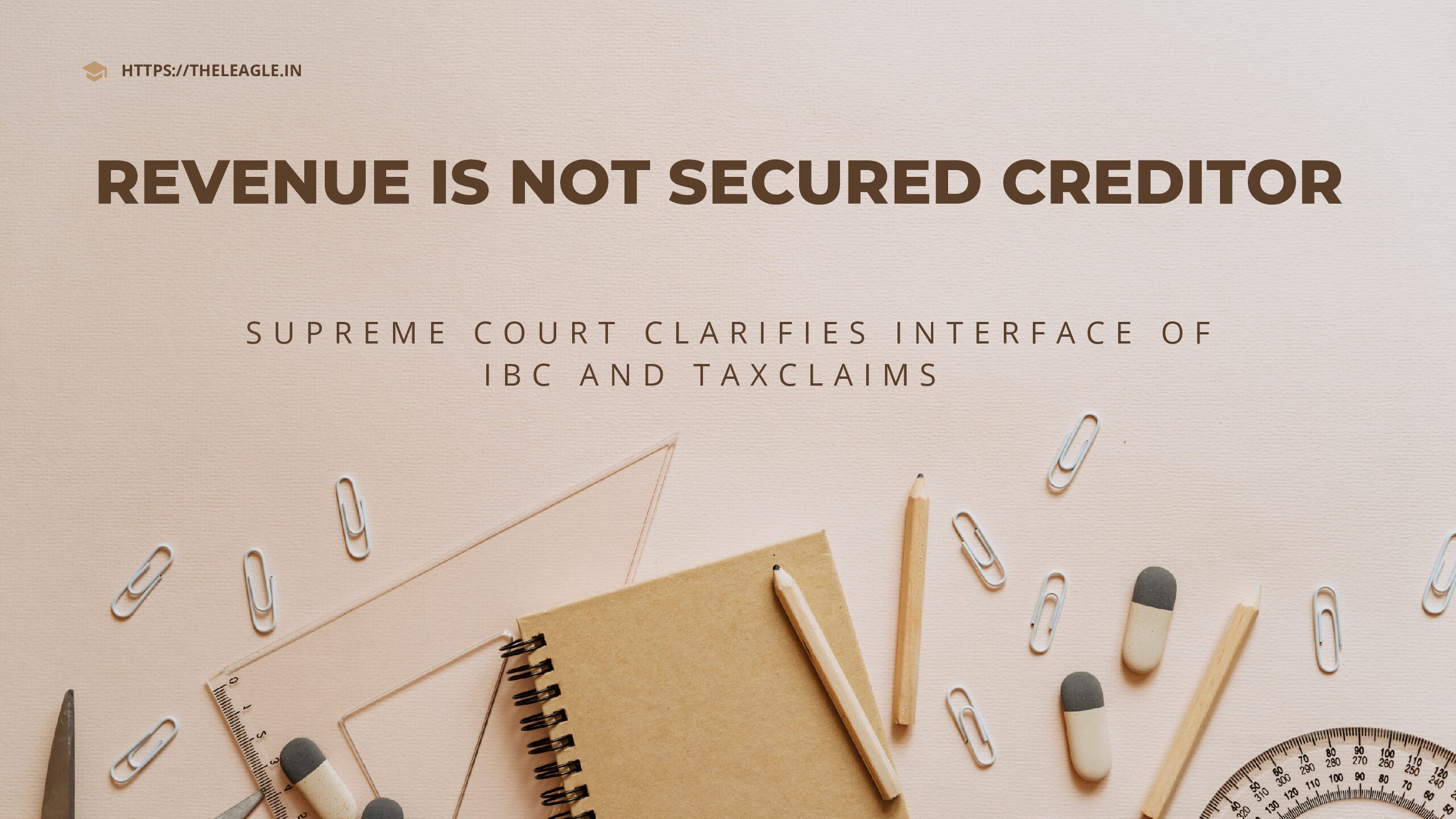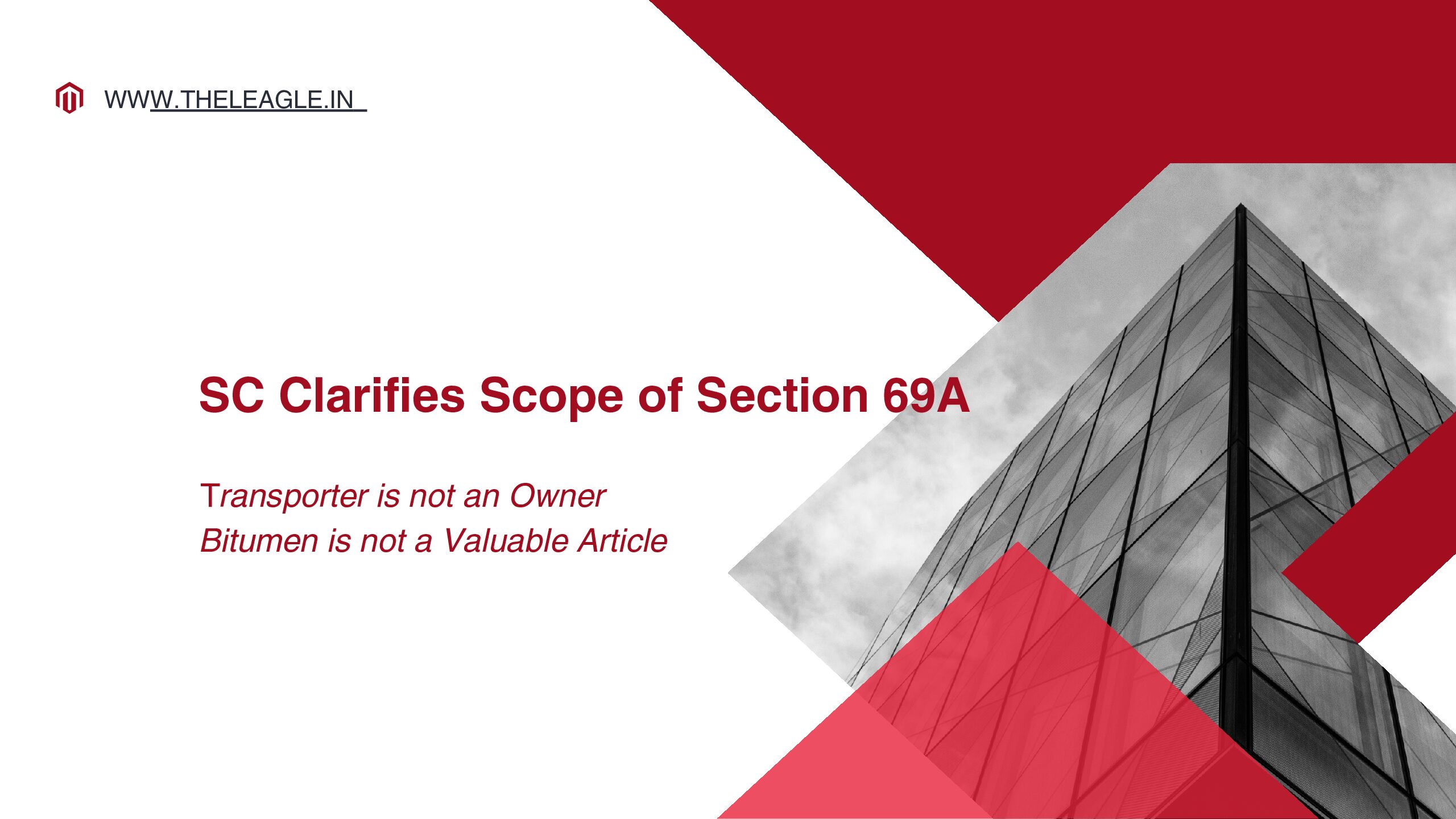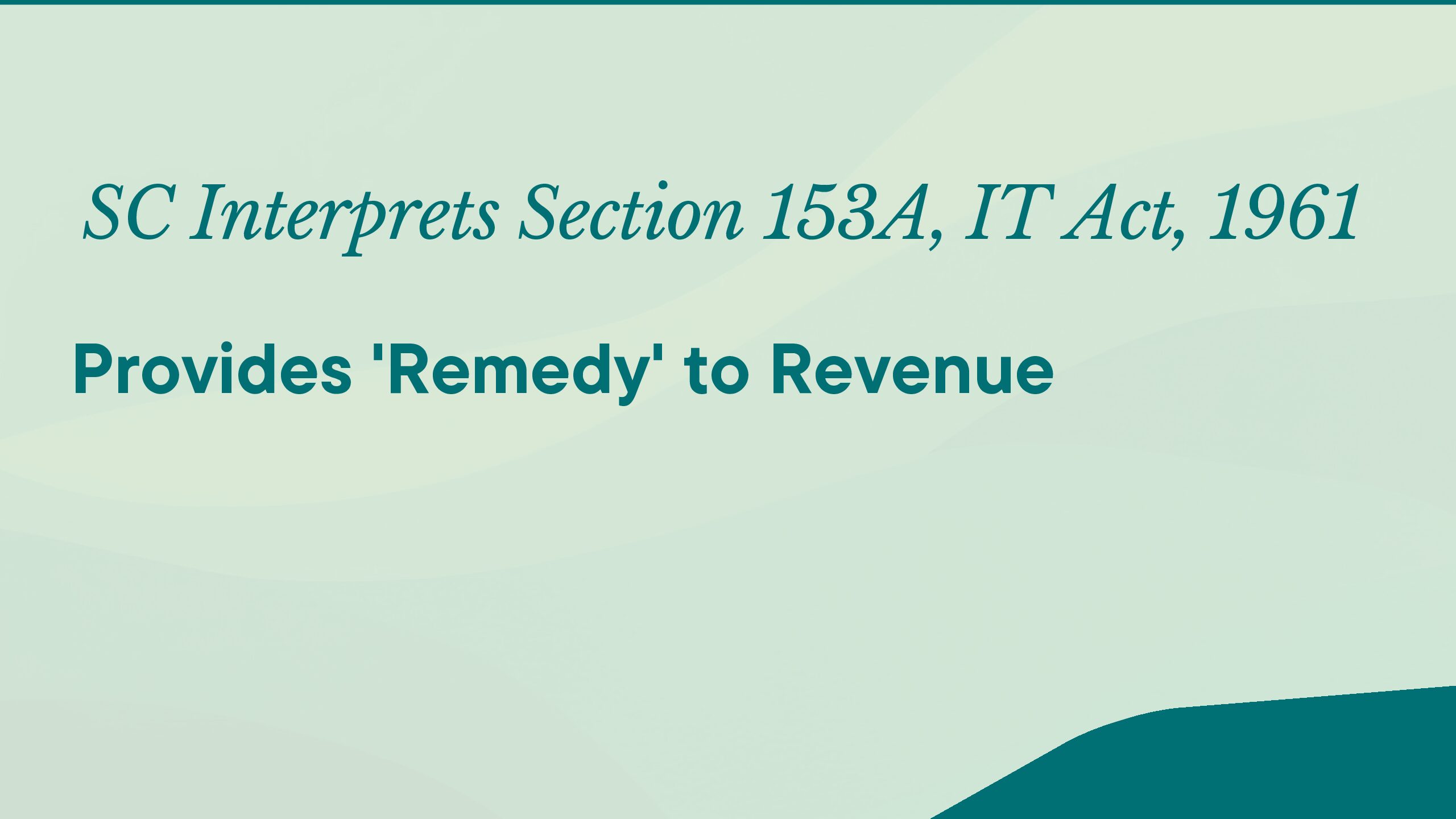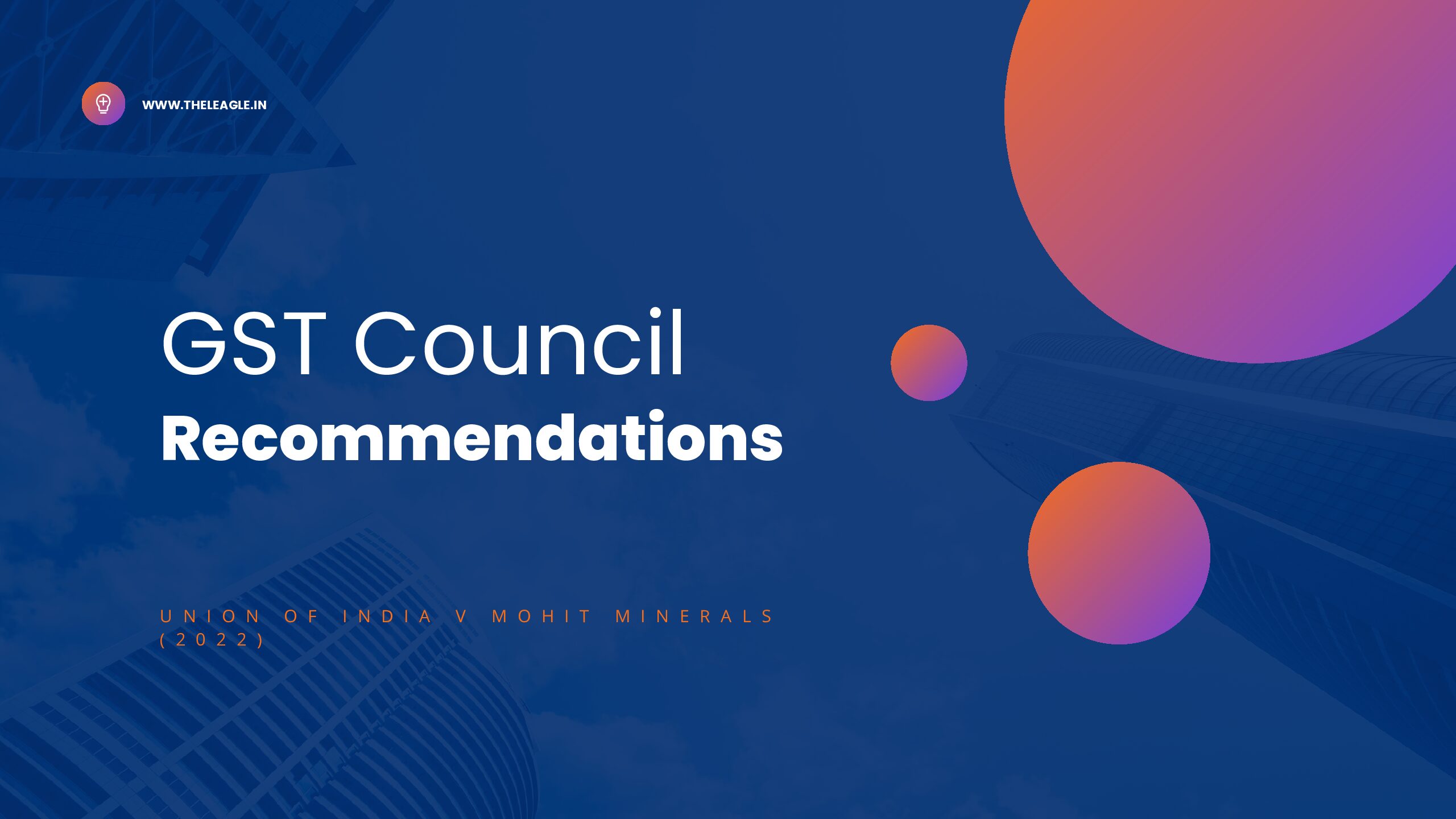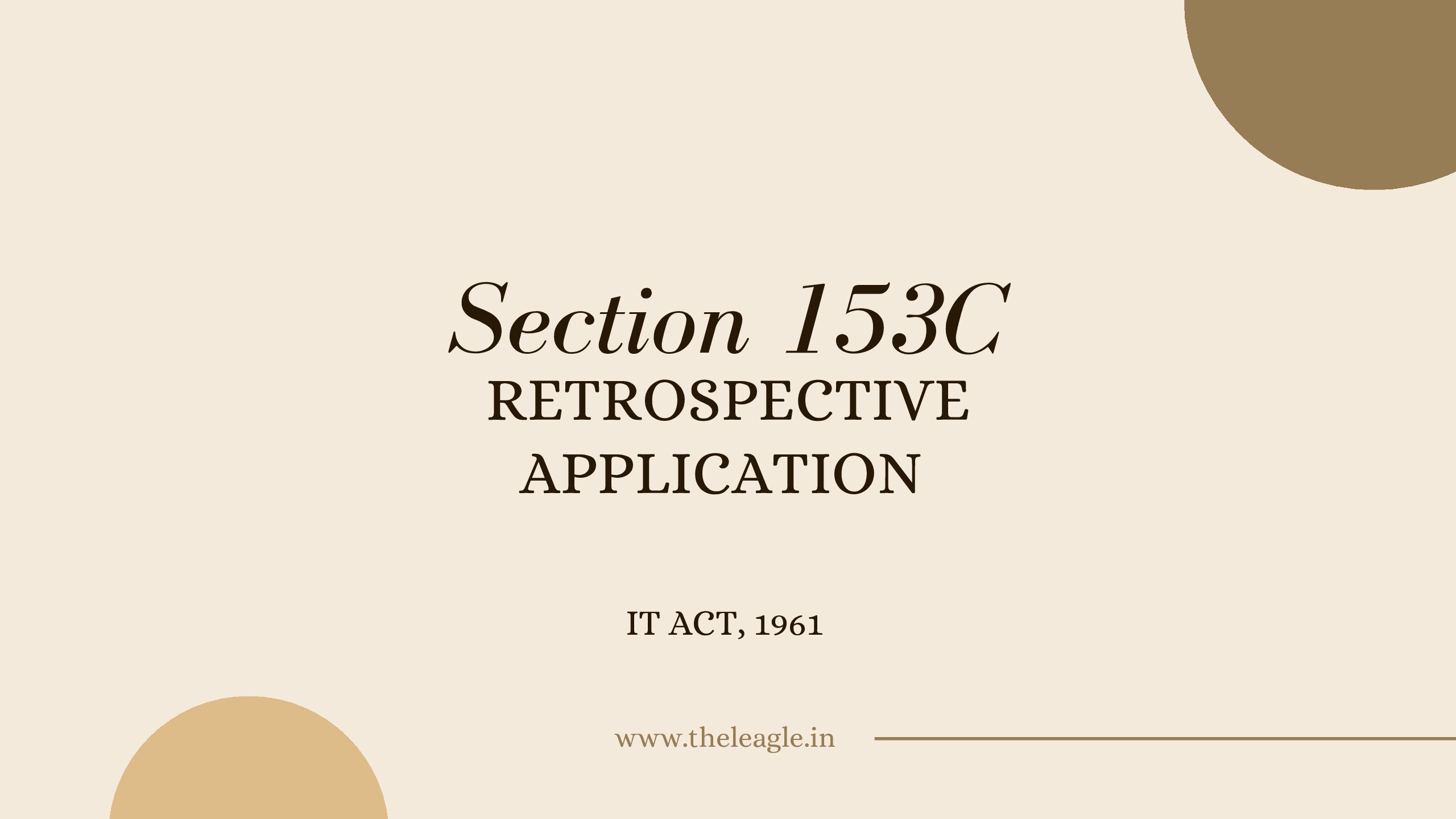In a recent judgment[1], a Division Bench of the Supreme Court engaged in depth with the scope, meaning, and implication of Section 19 of The Constitution (101st Amendment) Act, 2016 (‘101st Amendment’) which catalysed the introduction of GST. Section 19 was a transitory provision which stated that existing indirect tax laws would be valid for one year or until States amend them to bring them in conformity with the 101stAmendment, whichever was earlier. The Supreme Court opined that Section 19 was transitory in nature and for that one year it was the repository of competence of State legislatures powers to amend the existing/pre-GST indirect tax laws. It held that the said legislative power could not be exercised after the period of one year contemplated under Section 19.
Facts
The case involved three batch of appeals that arose from special leave petitions filed in the case.
First, related to the State of Telangana where the local VAT law was amended after coming into force of the 101st Amendment, i.e., 16.09.2016. State of Telangana amended the VAT law via an ordinance dated 17.06.2017 and thereafter the State legislature enacted a law replacing the ordinance which came into force on 02.12.2017. The amendment to VAT law was challenged and the Telangana High Court struck it down on the ground that State legislature could have exercised the power of amendment under Section 19 of the 101stAmendment only to bring the VAT law in conformity with GST laws. Also, the Ordinance could not have been confirmed since the State was denuded of legislative competence under Section 19 after 01.07.2017. Since GST laws came into force on 01.07.2017, the one year time period under Section 19 expired on the said date.
Second, in the Gujarat batch of cases Section 84A was introduced in the Gujarat VAT Act, 2003 via an amendment gazette on 06.04.2018 with retrospective effect from 01.04.2006. The aim of introducing the said provision was to enable to the Revenue Department to open assessments which had attained finality. The Gujarat High Court struck down the amendment on the ground of lack of legislative competence on part of State legislature after 01.07.2017 and also on the ground that the amendment was manifestly arbitrary.
Third, involved amendment to the Maharashtra VAT Act. On 15.04.2017 the amendment to the said act was gazetted and thereafter an explanation was added via an Ordinance w.e.f. 06.03.2019. Thereafter, on 09.07.2019 the Ordinance was replaced by the Amendment Act which inserted various provisions including the said explanation. The amendment was upheld by the Bombay High Court and appeals were filed in the Supreme Court against the judgment.
Legal Issue and Arguments
I think, it is best to upfront cite the provision that was the centrepiece of the judgment, i.e., Section 19 of the 101st Amendment which states as follows:
Notwithstanding anything in this Act, any provision of any law relating to tax on goods or services or on both in force in any State immediately before the commencement of this Act, which is inconsistent with the provisions of the Constitution as amended by this Act shall continue to be in force until amended or repealed by a competent Legislature or other competent authority or until expiration of one year from such commencement, whichever is earlier. (emphasis added)
At first glance, Section 19 reveals three things: first, it is a transitory provision; second, it allowed the States to amend pre-existing sales tax provisions make them consistent with the 101st Amendment; third, pre-existing laws such as VAT would cease to have force after one year of commencement of the provision or when they were amended or repealed, whichever was earlier. The one year was until 01.07.2017 when the GST laws came into force. The Supreme Court had to adjudicate on the nature and extent of legislative power conferred to the State legislatures under Section 19.
To justify amendments to its local VAT law, the primary argument that the State of Telangana’s counsel made was that the effect of an Ordinance and a law was the same, only their manner of creation differed. And that the difference was only about procedure adopted and not subject matter of both legislative instruments. Thus, when the State legislature approved the Ordinance to amend the VAT law was enacted on 02.12.2017, its terms ‘related back’ to the date when the Ordinance was promulgated, i.e., 16.09.2016. Thus, the State legislature’s power to enact the law was preserved even after 01.07.2017. (para 27)
Counsel for State of Maharashtra, in a similar vein, argued that the material fact was the existence of the legislative power with States and not the manner of its exercise. It was argued that Section 19 preserved the power of States to amend the laws and it was erroneous to state that the power to amend the laws was only confined to bring the existing laws in conformity with the GST laws.
The respondents led with their primary argument by drawing an analogy with Section 19 of the 101stAmendment with Article 243ZF of the Constitution.[2] They argued that the latter was incorporated in the Constitution – via 74th Constitutional Amendment – solely with the purpose of allowing amendments to existing laws and bring them in conformity with the new provisions of the Constitution. Similarly, they argued that Section 19 was limited in conferring legislative power to States, i.e., to bring existing laws in conformity with the 101st Amendment. The respondents relied on Section 19 not being made part of the Constitution text per se, but that it was only included in the Amendment Act and argued that it should be interpreted restrictively. The respondents further argued that interpreting the term ‘amend’ used in Section 19 to confer a power on States to make a law wider than curative legislation which runs contrary to the revised Constitutional architecture introduced by the 101st Amendment would not be in aid of the said Amendment.
Supreme Court’s Observations on Section 19
The Supreme Court, in a well-reasoned and detailed judgment has described the changes introduced by the 101st Amendment, its rationale, and the nature of transitory provisions among other things. In this post, I will elaborate on its three main observations on Section 19 that I think are relevant from the perspective of examining the interface of the Constitution and tax.
First, one of the issues that the Supreme Court had to engage with was the effect of Section 19 not being included in the Constitution itself unlike, for example, Article 243ZF. And whether Section 19 was only ancillary to the 101st Amendment and thereby required to be interpreted in a narrow fashion. Supreme Court observed that the purpose of Section 19 was to preserve the existing laws and allow the Parliament and States to repeal and amend them. Since the 101st Amendment deleted various legislative entries relating to indirect taxes, the absence of such a provision would have been ‘catastrophic’ and denuded the States and Union of such crucial legislative power. (para 74) Comparing Section 19 with Article 243ZF, the Supreme Court noted that:
However, the fact remains that those provisions as well as Section 19 were enacted in exercise of the constituent power. Section 19 is not, in this court’s opinion comparable to a mere Parliamentary enactment. There cannot be any gain in saying that Section 19 is not a mere legislative device. It was adopted as part of the 101st Constitutional Amendment Act. Undoubtedly, it was not inserted into the Constitution. Whatever reasons impelled Parliament to keep it outside the body of the Constitution, the fact remains that it was introduced as part of the same Amendment Act which entirely revamped the Constitution. (para 80)
The Supreme Court concluded that Section 19 was a transitory provision with limited life and whether it was part of the Constitution or not was academic, what was crucial was the effect of the provision. Thus, as per the Supreme Court the entire argument that Section 19 should be interpreted in a particular manner because of it being part of the Amendment Act but being included in the Constitution per se was irrelevant. Section 19 was enacted via the same process as other provisions of the Amendment Act and was a result of exercise of constituent power and not legislative power.
Second, the Supreme Court then opined on the effect of the first observation, i.e., Section 19 was enacted as a result of exercise of constituent power. The Supreme Court noted that the 101st Amendment had brought significant changes to the Constitution in terms legislative powers relating to indirect taxes via deletion of legislative entries and thus the legislative powers of States and the Union ‘had to be directly sourced from the Amendment’ in the interim period. (para 92) As per the Supreme Court, in the hiatus period between coming into force of Section 19 and operationalising Article 246A (under which the States and Parliament exercise legislative powers on GST) legislative power should be traced to Section 19.
In other words, the Supreme Court said that Section 19 was part of the Constitution since it was enacted through the same process as other provisions of the Constitution Amendment. And that since the 101stAmendment deleted previous sources of powers to levy indirect taxes and introduced new a locus of power under Article 246A, the source of legislative power for the transition period should be traced to Section 19. The ‘hiatus’ as per the Supreme Court was because the GST Council had not immediately recommended principles on the basis of which GST laws could be enacted in exercise of powers under Article 246A. And thus concluded that:
It is, therefore, held that there were no limitations under Section 19 (read together with Article 246A), of the Amendment. That provision constituted the expression of the sovereign legislative power, available to both Parliament and state legislatures, to make necessary changes through amendment to the existing laws. (para 97)
The legislative power under Section 19, as per the Supreme Court, was only constricted by time, i.e., till 01.07.2017 and not in any other manner as suggested by parties to the case.
The above is a liberal and expansive interpretation of Section 19 and goes far beyond what the text of the provision says. However, the Supreme Court justified by contextualising it and commenting on the drastic changes brought via the 101st Amendment. In my view, Section 19 only allowed States to amend existing provisions to bring them in conformity with the Constitution or enact new provisions to the same end. Section 19 did not allow States or the Parliament to enact any other provision for any other purpose. The restriction was not ‘only’ of time, but also of the nature and purpose of provisions that could be enacted and amended under Section 19.
Third, and this is an indirect but proximate point, i.e., the Supreme Court clarified that Section 19 could not be used to clothe a retrospective amendment with validity. In other words, while the VAT Act may have been validly enacted, but once the power of States to enact or amend such laws ceased on 01.07.2017, then the States cannot amend the laws after the said date on the ground that laws can be amended retrospectively to cure a defect. The Supreme Court clarified that what was material was the presence of competence on the date on which amendment to the law was made and not the date when the law was enacted. (para 115)
Conclusion
Supreme Court’s judgment in the impugned case is a well reasoned judgment that examines in depth the impact and nature of transitory provisions. While the Court may have, in my opinion, interpreted the scope of powers provided to the States more expansively than I think Section 19 provides, the end result nonetheless was that all the amendments to VAT Acts of the three States were held to be void on the ground that the States exercised their legislative powers once Section 19 had ceased to have effect. Telangana’s argument of ‘relating back’ was rejected on the ground that the State legislature did not possess competence on the date it enacted the amendment to approve the Ordinance. Similarly, the Supreme Court rejected the State of Gujarat’s argument that the amendment though effected after 01.07.2017 was retrospective in nature. Amendments by State of Maharashtra met the same fate.
[1] The State of Telangana V M/S Tirumala Constructions 2023 INSC 942.
[2] Article 243ZF of the Constitution states that: Notwithstanding anything in this Part, any provision of any law relating to Municipalities in force in a State immediately before the commencement of the Constitution (Seventy-fourth Amendment) Act, 1992, which is inconsistent with the provisions of this Part, shall continue to be in force until amended or repealed by a competent Legislature or other competent authority or until the expiration of one year from such commencement, whichever is earlier:
